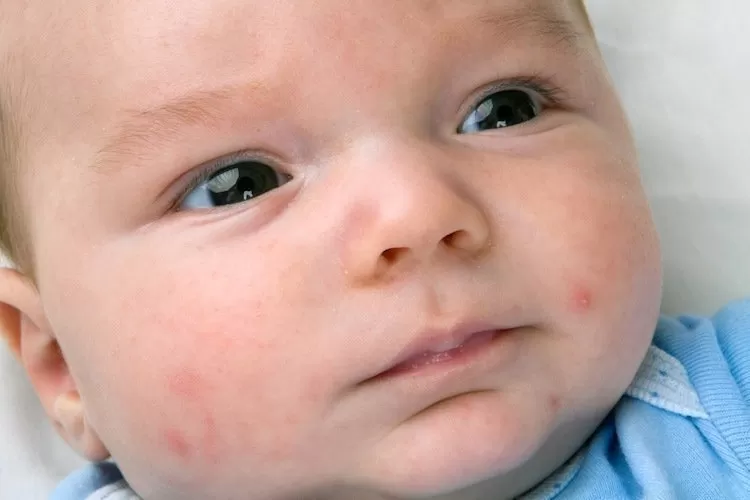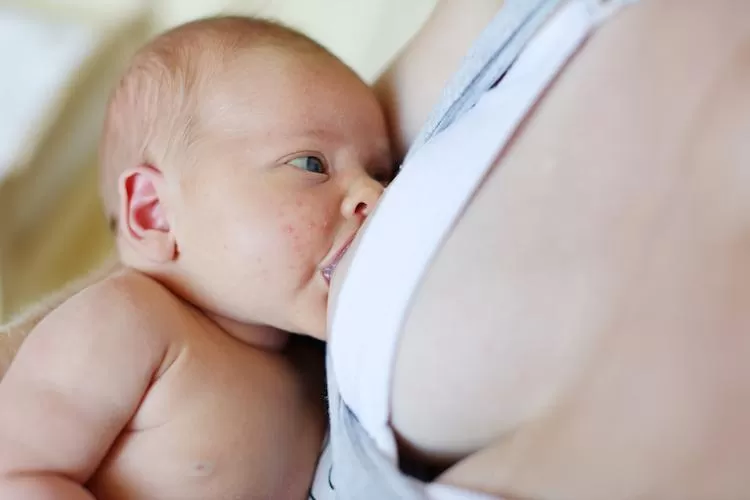Baby acne breast milk treatment is claimed to be a natural way to heal your baby’s skin. Here’s everything you need to know about breast milk, baby acne, and whether it’s a legitimate cure.
Baby Acne Breast Milk Treatment, The Lowdown

Baby acne breast milk treatment is natural, but does it actually work? Let’s take a look at the evidence…
What is Baby Acne?
Before getting into the magical properties of breastmilk and why it may be useful in the treatment of baby acne, let’s find out exactly what it is.
Baby acne is similar to adolescent acne – it looks like tiny red or white pimples and is a very common condition. It’s temporary and usually appears on the cheeks, nose, and forehead. Sometimes you’ll also find a few spots on the neck, chest, and back.
Baby acne normally clears up on its own with no problems.
If you notice your baby’s acne significantly increasing and creeping onto the ears and into the hairline, it may be a sign of an allergy rash.

What Causes Baby Acne?
There’s no definitive reason for acne in infants, but one of the most common theories is to do with the role of maternal hormones. Babies are exposed to surges of hormones whilst in utero, and again via breastmilk once born.
It’s plausible that these hormones fluctuations might manifest as acne, in the same way that they can trigger the condition in teenagers.
Other theories include sensitive skin in babies being more susceptible to clogging pores, or that yeast living on the skin may lead to acne.
Can You Really Use Breast Milk For Baby Acne?
While it may sound wild, using breastmilk as a remedy for baby acne is not such a crazy idea.
Around 6.2% of breastmilk is lauric acid, which has antimicrobial properties and may reduce or destroy the bacteria responsible for causing baby acne.

While there’s no current research to support this idea, studies have been conducted into the efficacy of breastmilk in the treatment of eczema and nappy rash, with varying degrees of success.
Since there’s no other specific treatment for baby acne, it probably can’t hurt to try using your breastmilk to help alleviate the associated irritation and inflammation of your baby’s acne.
How to Use Breast Milk on Baby Acne
Your liquid gold breastmilk is a great option for trying to improve your baby’s skin condition: it’s gentle, natural, and easy to acquire!
After washing your hands, simply dab a little breastmilk on the affected areas, or soak a clean cotton wool pad and gently wipe over your baby’s face.
Since breastmilk doesn’t contain harsh chemicals, you can repeat this treatment after each feed if you wish.
How Long Does Baby Acne Last For?
Baby acne can last anywhere from just a few days, up to three or four months. Most cases will disappear within two weeks.
If your baby’s acne develops after six weeks of age they may have infantile acne which differs from baby acne and may require assessment by a paediatric dermatologist.

How to Care For Baby Acne
In addition to the use of breastmilk as a topical treatment, here are some more tips and recommendations to help clear up baby acne:
- Bathe your baby with warm water only.
There’s no need to bathe your baby every day or to use harsh soaps which may irritate newborn skin.
If you do feel you want to use a product, be sure to use one which is gentle, fragrance-free, and designed specifically for the sensitive skin of infants.
- Don’t break the skin.
Just about the worst thing you can do for baby acne is to give in to the temptation to scrub or pop the pimples.
Broken skin removes the protective barrier preventing infection, so it’s important to be gentle when wiping your baby’s face or applying breastmilk, and put gloves on your baby’s hands to prevent scratching.

- Don’t use moisturiser on your baby’s face.
Avoid using any other kind of products on your baby’s sensitive skin.
In the womb babies have a protective substance, called vernix caseosa, covering their skin, which is often still present at birth. Vernix is waxy and acts as a natural moisturiser for your newborn’s skin, meaning lotions shouldn’t be necessary.
Even coconut oil and olive oil – which are recommended as suitable options for baby massage – are not a good idea for use on the face. They’re comedogenic substances, meaning they’re likely to clog the pores, trapping dirt and bacteria and leading to acne.
Breast Milk / Baby Acne FAQ
Q: Can my breast milk be causing baby acne?
A: As discussed above, it’s possible that hormones in your milk may contribute to your infant’s baby acne. However that’s not proven, and the benefits of breastfeeding far outweigh the temporary skin condition.
If you notice acne occurring specifically where breastmilk pools after nursing, gently wipe away excess milk after feeding.
Q: Does mother’s diet cause baby acne?
A: The mother’s diet is not relevant to baby acne, since it has little influence on the composition of breastmilk.

Q: Does breast milk help with acne?
A: Anecdotally, it can. However there has been research to verify this.
Given that breastmilk has antimicrobial properties and is both natural and gentle, there’s no harm in testing its effect on your baby’s acne, if you wish to. However, baby acne usually clears on its own within a few weeks.
Q: What causes baby acne to flare up?
A: If your baby presents with acne it will usually remain fairly consistent until it begins to clear. You might notice it appears more inflamed and angry when your baby is hot and/or fussing.
If you formula feed, you may find that where the milk pools aggravates your baby’s acne, in which case simple wipe the excess away after feeds and gently clean the area with cooled boiled water on a cotton wool pad.
If you see your baby’s skin condition worsening, it may be worth considering whether there is something more going on, such as a milk allergy rash.
Other Amazing Uses For Breast Milk

With the impressive antimicrobial, antiviral, anti fungal, and anti inflammatory properties of breast milk, there are several possible therapeutic uses for your liquid gold besides treating baby acne.
Note: Though anecdotally there’s plenty to support the use of breastmilk for the following ailments, there’s no scientific evidence showing its efficacy. To err on the side of caution, always seek advice from your health profession.
- Ear infection
This one divides opinions so exercise caution and definitely seek medical advice before experimenting with this.
Some health professionals say a few drops of breastmilk can soothe pain and speed up healing, while others advise against liquid going into the ear canal.
- Conjunctivitis
Gunky eyes are common in newborns, and a few drops of breastmilk is said to work wonders at clearing up mild infections!
- Cradle cap
Apparently a little breastmilk massaged into problem areas can loosen cradle cap – and being topical there’s no harm in giving this one a try!

- Eczema, chicken pox, and other rashes
Eczema, nappy rash, and even chicken pox and stinging nettle rashes may be soothed by a little breastmilk. The anti inflammatory properties may help to reduce itchiness and irritation, and promote healing.
- Cracked nipples
I know about this one from experience. I also know the horrors of being allergic to lanolin and inadvertently making it worse. Save your money and use the magical stuff you make for free!
- Insect bites
Similarly to rashes, the incredible qualities of your liquid gold can also help to alleviate the swelling and soreness associated with insect stings and bites.
- Cuts and scrapes
If you have an accident-prone toddler then they too can benefit from your breastmilk! Use in place of saline solution or antiseptic cream to prevent infections.
- Burns
Try using breastmilk to relieve minor burns including sunburn. Ensure the area is clean, and then use a little to soothe and help keep the area sterile and infection-free.
So you see, breastmilk really is liquid gold!
